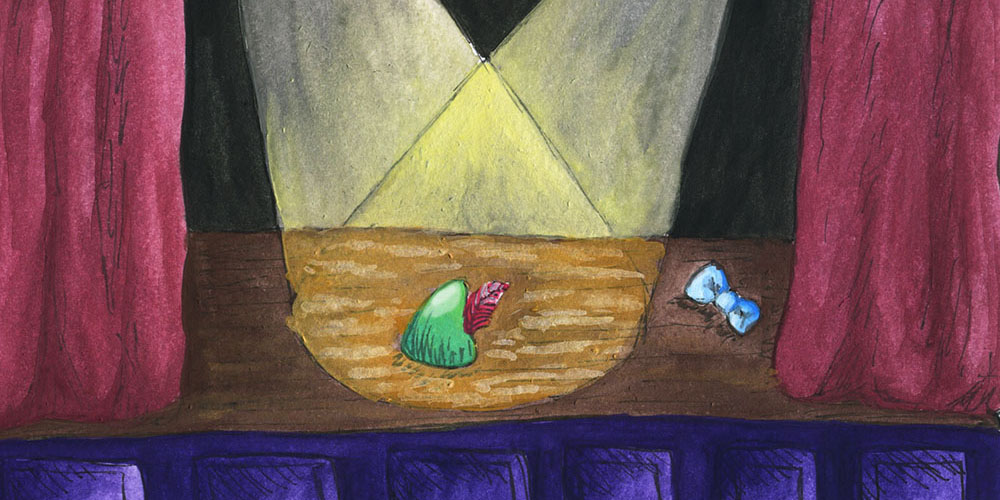I was sitting on the porch of a rustic cabin in Canada, halfway through my decade with Eric, when I realized that I was no longer the title character in my own play. We had come to this quiet spot, with a small entourage, in an attempt to revive the simple joy of Eric’s youthful summers. While he and a friend trawled the lake for fish, I prepped for an article on the centennial of James Barrie’s Peter Pan. The play premiered at the Duke of York’s Theatre, London, in 1904, delighting audiences with its tale of a boy who wouldn’t grow up, who rejected even his darling Wendy to pursue a life of untethered adventure. Sitting in the long rays of the northern sun, I re-read Peter and Wendy, Barrie’s novelization of his play, published in 1911. I wondered about the title change. What had Wendy done in those intervening years to earn equal billing with her more fascinating protagonist?
I was especially intrigued because her love for Peter, and her fascination with him, were precisely what I’d felt in the early years with Eric. Wendy’s role as mother to the Lost Boys, compensating for Peter’s self-involvement, was one I often played among Eric’s colleagues at his upstart theatre company, which was just beginning to draw national attention. Wendy and I even shared a tragic flaw, believing that we could transform our partners into deep-thinking, empathetic men, and being consistently surprised when we failed.
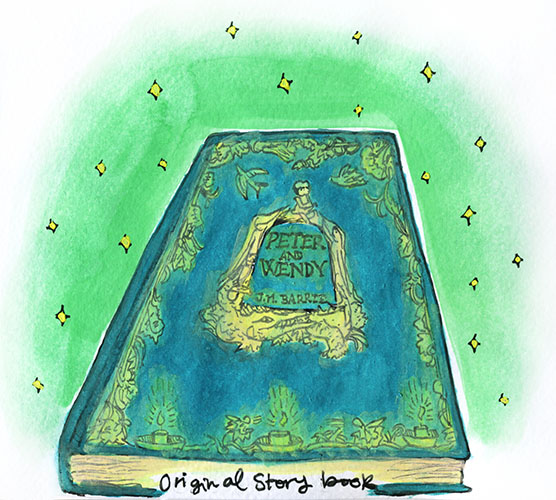
I’d known Eric for five years, but I’d known Peter for a quarter-century, ever since playing the role of Wendy’s brother, John, in the musical version of Barrie’s play. Peter was played by Margie Belrose, a 40-something pixie with great charm and greater chutzpah. Her Vaudeville Showcases, presented at the Belrose Studio Theatre, featured local comics, dancers, singers, and always ended with Margie alone on the edge of the stage, Garland-like, singing “Life Is Just A Bowl of Cherries.” A successful debut singing “The Trolley Song” with my friend Kim landed me the role of the nebbishy John. Every night of the run, I feigned sleep in my cramped bed while Peter and Wendy got acquainted in the Darling nursery. That brilliant opening scene, sans pirates or mermaids, is where we learn that Peter has never been touched, that he has no knowledge of kisses. Later, in Neverland, I knelt among the Lost Boys as Margie sang “Distant Melody,” a lullaby barely remembered from Peter’s brief life among adults.
Knowing Margie first as a 40-something, single mother of two, struggling to keep her dance school afloat, I experienced her onstage cry of, “I’m youth. I’m joy!” as a melancholy note in Barrie’s work long before I recognized the play’s dark underpinnings. When I read the original 1904 manuscript, I discovered things the musical omits, most significantly Peter’s line, “To die will be an awfully big adventure.” The following year, writing about Barrie for a high school English project, I came across the play’s inspiration — the five Llewellyn Davies boys whom he met in Kensington Gardens and for whom he spun magical tales that would become the foundation of his masterpiece. In dedicating the published play “To The Five,” Barrie wrote, “I made Peter by rubbing the five of you violently together, as savages with two sticks produce a flame. That is all he is, the spark I got from you.”
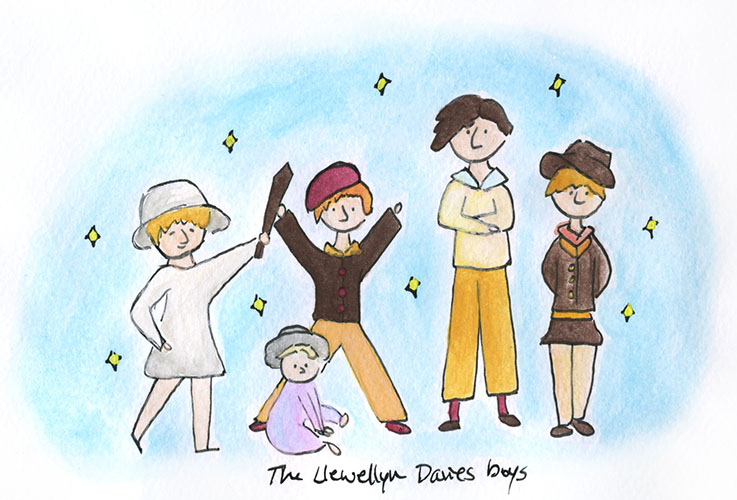
The boys became my obsession. George, the eldest, a genial and hearty fellow, died in the trenches of World War I. Peter was somber, even dark, the most like Barrie himself. He wrote that “melancholy has marked me for her own,” and was 63 when he threw himself in front of a Tube train. Practical Jack was well suited to his future career in the Navy but not to Barrie’s whimsical tales. Nico, the youngest, was at ease with life in a manner similar to his eldest brother but managed to outlive him by seven decades. It was Michael, the fourth of the boys, who carried a touch of mystery. With a poet’s heart and twinned streaks of melancholy and joy, he was a true Barrie creation. In his later years, Nico wrote to Barrie biographer Andrew Birkin, “We all knew that George and Michael were The Ones — George because he had started it all, and Michael . . . because he was the cleverest of us, the most original, the potential genius.”
I enrolled in a study tour of England and Scotland the summer before my senior year of high school in the hopes of tracking the Llewellyn Davies’ story and had my London A-Z in hand when the orientation packet arrived. I quickly determined that our two nights on Queensberry Court would put us just blocks from Kensington Gardens. On my first morning in London, I rose early, dressed quietly in the space between the room’s three narrow beds and slipped onto the streets. Passing through Queen’s Gate, I entered a world already familiar from Barrie’s prose and Arthur Rackham’s illustrations.
Peter Pan’s first literary appearance was in The Little White Bird, in 1902, and his home is in Kensington Gardens, not Neverland. A largely autobiographical tale about a military man who befriends a young family, its central chapters (later published as Peter Pan in Kensington Gardens) tell of Peter’s life among the faeries in the very place where
Barrie first met five-year-old George Llewellyn Davies in 1897, and where I ventured on my first morning in London.
The Broad Walk drew me from Queen’s Gate to the Round Pond, which was larger than I expected but empty of the toy sailboats that would ply its waters later in the day. I looked beyond to rolling grassland and spreading oaks; the perfect place for a childless author to weave stories for an audience of little boys and the drooling St. Bernard who paced beside them.
Even at that early hour, stout middle-aged women were walking their dogs. A dachshund made good speed, incognizant of the two-wheel contraption that supported his lifeless hind legs. Strolling down through the wet grass, I was soon walking along the banks of the Serpentine. Rounding a corner, I came upon Peter’s statue with its twisting pedestal of faeries, birds, and squirrels. I knew from my studies that it had been modeled on Michael, and I’d seen the photos that Barrie took, to send to sculptor George Frampton.
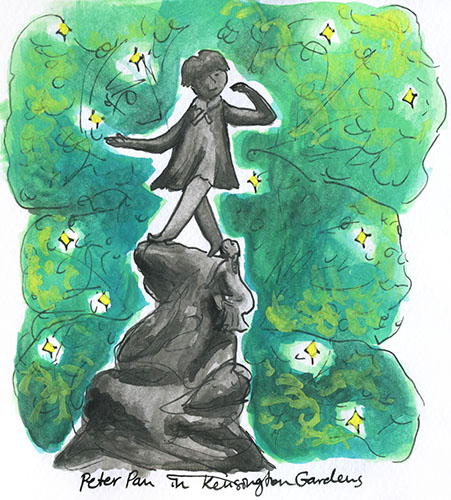
It was a happy family that Barrie encountered in 1897. The boys’ mother, Sylvia, was the daughter of illustrator George du Maurier, famous for his work in Punch. Her brother Gerald would originate the role of Captain Hook and become one of the leading actor-managers of the new century. Arthur Llewellyn Davies, the boys’ father, played the more humble role of barrister and family provider. Barrie’s appearance, before Michael and Nico were born, was like Peter’s entrance at the windows of the Darling nursery, bringing unimagined delights and unusual complications. His generosity was not always welcomed by the hardworking Arthur, and his attentions to Sylvia would complicate his own, already complicated marriage.
A year after that first, quick stroll through the Gardens, I was back in London to begin my freshman year of college. In the used bookstores of Charing Cross Road I purchased the first volumes of my now extensive Barrie library. I loitered in front of the Barries’ home on Gloucester Road and ventured out to Farnham, where the author and his wife welcomed the Llewellyn Davies clan to Black Lake Cottage for a summer holiday, and from whence Mary Barrie would escape to the arms of a younger man. My obsession proved the perfect excuse for a trek to the Outer Hebrides, traveling by mail bus and boat to Amhuinnsuidhe, where Barrie and the boys enjoyed a fishing holiday.
Memories from the Llewellyn Davies’ lives seem as vivid as my own: suffocating silences in dark rooms, sunlit days by the sea, crowded theatres, stalwart farewells as railcars head for the Channel filled with young men in fresh uniforms. There’s Barrie waiting patiently as Arthur converses by jotting on a pad, his upper jaw removed in hopes of halting the encroaching cancer. And Barrie again, at Sylvia’s deathbed, saying farewell to a beloved friend before going out to tell the boys, ages six to 17, that their mother was gone. Named their legal guardian, “Uncle Jim ” became benefactor, confidante, and father.
His relationship with The Five was distorted in the usual ways for the Hollywood tearjerker Finding Neverland, and scholars seeking notoriety have accused Barrie of unhealthy inclinations. Nico told Birkin, “I am quite unable to admit that J.M.B.’s influence was ‘unhealthy;’ oppressive maybe and over-constant . . . But so far as I am concerned, speaking as the fifth brother, I’m glad I lived with that odd little man rather than living in poverty, or, for that matter, with virtually any other person I have ever known.”
From the beginning, Barrie captured the boys’ imaginations, and trust, by never avoiding the dark shadows in the stories he told. Plays like Mary Rose and Dear Brutus have the same sorrowful elements that lift Peter Pan above the era’s obsession with childhood innocence. In the first, a young mother disappears on a Hebridean island only to return unchanged when her child is an adult, making them contemporaries. In the second, each character is given the chance to correct a misstep in their past but each repeats the mistake. In Barrie’s masterwork, Peter is forced to spend eternity in pre-adolescence, never growing, never learning, and never loving.
I thought I understood Peter Pan as well as anyone could, but it took my own late arrival at adulthood to open my eyes. Through my 20s, I was Pan-like myself, embracing the adventure of life, proudly dismissive of my peers’ more practical career plans. I bounded from passion to passion, like Peter leaping across the chimney tops of London. A love affair that lasted only months landed me in Boston for a decade. A four-year sojourn on Cape Cod allowed me to live cheaply and focus on becoming a writer. It was there that I fell for a park service ranger and entered into a life of domesticity. We moved together to Washington, D.C., one of the few places where both a ranger and a theatre artist can get work. At 30, I met Eric.
Like Peter, Eric lured me from the safety of that stable, domestic existence into the heady swirl of life in his fledgling theatre company. He was irresistible, with all of Peter’s life-embracing charm wedded to an adult awareness of friendship, sex, and ambition. There was even a stand-in for Tink, a trusted female friend jealous of all rivals and longing for a romantic relationship where none could exist. Like Wendy, I leaped through the nursery window with little thought for those I left behind.
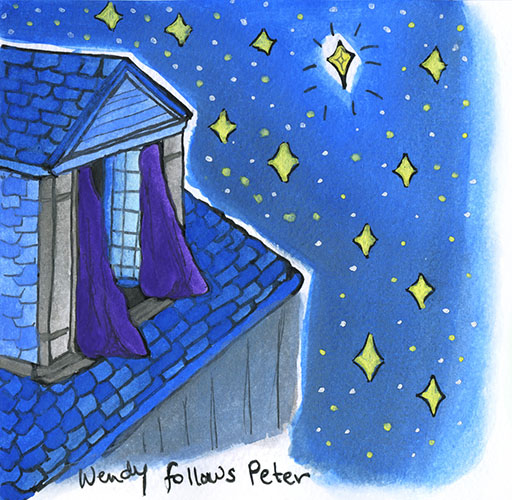
Eric offered adventures that rivaled swimming in Mermaid’s Lagoon or fencing with Hook on the deck of the Jolly Roger. I was soon accompanying him to Broadway openings, celebrity-studded galas, and intimate parties at Steve Sondheim’s Turtle Bay home. We spent six months in London, where Eric directed a flop musical for Cameron Mackintosh and I ventured often to Kensington Gardens, to nap beneath the trees. They were heady days, full of excitement, and growing discomfort.
Finally, sitting on that porch in Canada, Barrie’s classic tale in my lap, I came to recognize Peter as the mere catalyst for Wendy’s transformation. Perhaps Barrie realized this himself when he added her name to the title. He even gives her the happy ending that Peter lacks. At the close of the book, he notes that Wendy is married “in white with a pink sash.” When he reports the birth of her daughter Jane, he adds, “This ought not to be written in ink but in a golden splash.”
Wendy takes the risks, enjoys the adventure, then has the courage to leave Peter behind and embrace the challenges of adulthood. Of course, she and her brothers are only absent from London long enough for their parents to begin mourning, while my sojourn in Neverland lasted a decade, long enough for my beard to turn gray and my hairline to recede. But Wendy and I left our adventures with the same epiphany: we discovered who we don’t want to be.
Wendy chooses to lead the Lost Boys back to London when Peter informs her that even mothers don’t wait forever. My turning point came in a newly renovated kitchen when Eric, knowing I wanted a family, allowed that he would consider adopting. I replied, “Putting on shows will always be the most important thing to you. I don’t want to raise a child who knows he’s not his father’s top priority.” Eric had the good sense not to object but a shift had occurred, and it wasn’t long before I was single again.
There’s no mention of the man Wendy finally chooses. Given the historical context, he likely saw action in the trenches of the Great War, and needed a woman of Wendy’s unique history to nurse him back to life. He’d be a quiet person, slow to speech. His youthful drive to experience as much of life as possible would have been quenched early, by challenges that Peter can’t comprehend. And Wendy would know from experience not to mold him into the perfect mate, to give him room to breathe.
When I think of London now, it’s not of the early days when I haunted the bookshops, nor the heady summer when Eric and I lived our lives in first class. London is now the memory of a single autumn weekend when my partner Gary asked me to show him the places I love. We stood before the statue of Peter Pan an hour after catching the train from Heathrow, then sat over tea and scones at the edge of the Serpentine, gazing on the bridge featured in Arthur Rackham’s illustrations, and imagining Peter sailing under in a bird’s nest, his nightshirt catching the wind.
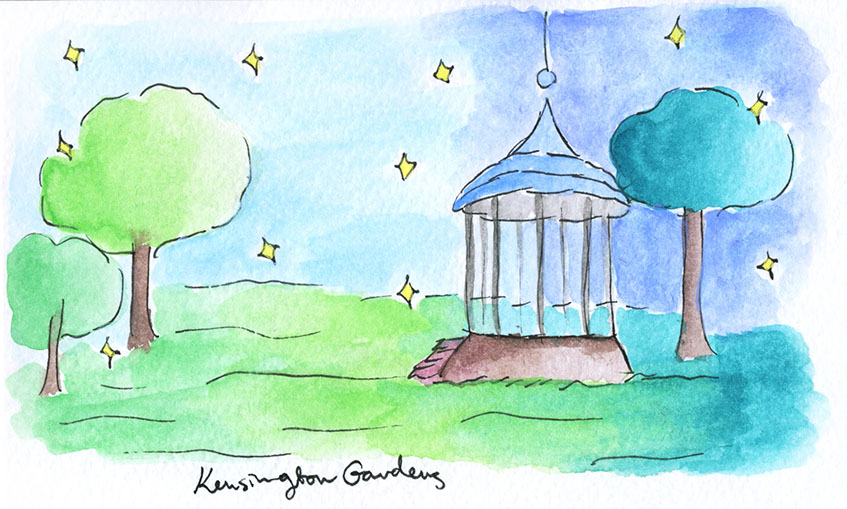
Gary and I met at the Unitarian Universalist church where he works and where I was a new member. We got to know each other slowly, enjoying each other’s ability to dive deep into conversation and to sit — sometimes — in silence. Like Wendy’s unseen husband, Gary spent his time in the trenches and shouldered an undue share of troubles. Quiet to a fault, he reads incessantly, is a junkie for news, and revels in the modern devices that so efficiently support the restless mind. He also came ready-made with a son who draws my most Wendy-like qualities to the fore.
Adopted from a Russian orphanage at nine months, Isaac missed out on the affection and play essential to early development but has a warm and welcoming spirit. He was 11 when we met, and brandishing a wooden sword of his own making. Soon he had keys to my apartment and would let himself in after school to keep my old dog company. Like all adolescents, he is Pan-like in his self-absorption, but now, at 16, he describes my strengths and weaknesses with disturbing accuracy and, when my mood is dark, asks, “You’re okay, right?” Recently, he’s taken to faking us out, pretending to have transgressed just long enough to see our anger boil — then laughing in delight when he reveals his innocence.
On our second day in London, Gary and I went to Hampstead for a ritual I had enacted alone on every visit since college. Embarrassed, I tried to back out, telling Gary that it wasn’t important. He insisted that I lead the way, first to the flower stand on Oriel Place, then up to Church Row. We lay the flowers at a gravestone that names Arthur, Sylvia, George, and Michael, though George is buried in France.
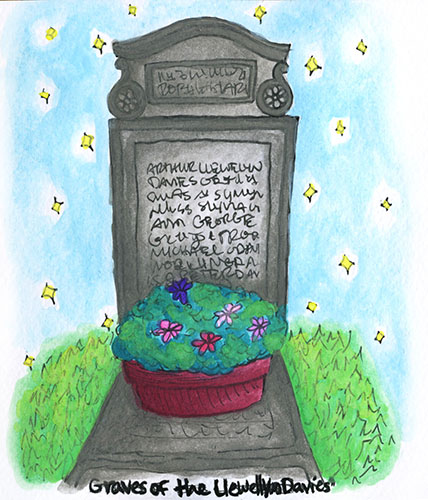
Michael, 20, had shown promise as an artist and poet and dreamed of studying in Paris. At Eton when The Great War ended, he wrote to Barrie of his future, “I’ll do anything you like. P.S. How about my going round the world?” Barrie found it difficult to let the boy go, especially with George so recently deceased, and insisted on Oxford instead. On the evening of May 19, 1921, a journalist approached Barrie as he stepped outside to mail Michael’s nightly letter. His body had been found in Sandford Pool, an offshoot of the Thames, entwined with that of Rupert Buxton, a close friend and fellow student at the university.
In a letter of condolence, Barrie wrote to Buxton’s mother, “Michael was son and daughter to me, and all I have been doing of any account in the last ten years was trying to be father and mother to him.”
Some scholars claim that Barrie was, himself, the “boy who wouldn’t grow up.” It’s clear, though, that he had a healthy streak of Wendy in him as well. In the midst of the war he established a refuge for French orphans in the Marne. He donated the copyright for Peter Pan to the Great Ormond Street Hospital for Sick Children. But he lacked Wendy’s strength when it really mattered. She had the confidence to let Jane fly off to Neverland and begin her own adventures, while Barrie kept Michael close.
Afternoons find Isaac and me working through his homework at our kitchen counter, though math problems have to wait for his dad. We sit down to dinner most nights for a meal that too often consists of burritos purchased by Gary on his way home. The conversation ranges across jobs and school and inevitably touches on military history and the expansion of empires, which is Isaac’s particular area of interest. (In Barrie’s original play, the Lost Boys cheer Peter’s conquest of Hook’s ship with “He’s Napoleon – Napoleon!” and Peter responds, “That’s who I am — Napoleon! He was little too!”) As a teenager, he’s right on schedule, pushing back against the structures we’ve put in place, sneaking cigarettes and obsessing about girls.
With my own Pan-like self-absorption, I have to ask, “What about me?” I enjoyed adventures that rival Wendy’s days in Neverland. I echoed her strength in leaving Peter. I grew up to partner with a steady, quiet man, and managed to create a family of my own. Soon, though, I’ll face Wendy’s — and Barrie’s — greatest challenge. I’ll have to leave my child in the nursery unsupervised, and the window unlocked. •
